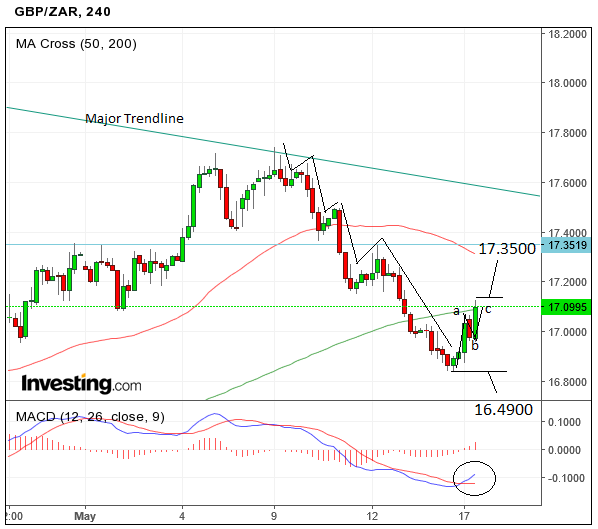Midweek Forecast for the Pound to South African Rand

The South African Rand has recovered on the back of a rise in commodity prices over the last week which on GBP/ZAR has been reflected in a mini-downtrend which began after the May 8 peak.
The Rand is seen as part of the commodity bloc of currencies which often rise and fall in tandem with global commodity prices because to a large degree their economies rely on them.
In the last week, we have seen commodities recover after China raised the possibility of more infrastructure spending and the two largest oil exporting nations of the world decided to limit supply to boost the price of oil.
The effect was to pull up all commodity currencies with the Rand taking part in the general re-evaluation.
On the four-hour chart of GBP/ZAR this was reflected in a move down from a peak at May 8 at the level of a major long-term trendline in the 17.30s (Rand rising equals GBP/ZAR falling).
From a technical perspective, this move lower – though clearer on an intraday chart – could be the start of a new short-trend lower, as it shows a descending pattern of lower lows and lower highs.
The rebound which has just begun (on the evening of May 16) has been very strong but remains too small to signal a change in the mini-trend.
It could just be a common three wave abc correction which will result in a resumption lower once it completes.
A such there is every possibility of a fall back down and a continuation of the mini-downtrend.
A move below the 16.83 lows would signal a continuation to the next target at 16.49.
It is too soon to posit a case for further gains over further losses, however, the move up over the last 24 hours has been very strong and this is often a sign of a new uptrend evolving.
We do not discount the possibility of this surge evolving higher, and a break above the 17.10 level and 200-4hr moving average would support confirmation of more upside, to a level at resistance at 17.35.
The MACD indicator is showing an ‘upturned toe' (circled) whereby the MACD is crossing over the signal line. This is a bullish scenario, although, for more confidence of further upside, we would want to see a move above the zero-line.

High Streets in Focus
Data out today has seen a higher-than-expected 0.8% rise in South African Retail Sales in March, beating analyst’s estimates of -0.7% and the previous -1.8% print.
The positive result may explain why GBP/ZAR has stopped in its tracks higher.
The next major release for the pair is from the UK on Thursday morning at 9.30 BST.
Retails Sales will probably be the most significant release of the week as it covers the UK economy’s current weak spot.
Consumer spending has slowed in the first quarter as the weak pound has pushed up shop prices for imports, which has caused a slowdown in spending.
Given consumer spending accounts for the largest proportion of GDP, this not a positive sign for the economy.
Slower growth will lessen even further the likelihood of the Bank of England (BOE) bringing forward the time when they will raise interest rates.
And given relatively higher interest rates tend to attract more capital flows which increase the value of a currency the pound stands to lose out if the BOE adopt a more dovish tone – which by dovish means more inclined to cut rather than raise interest rates.










